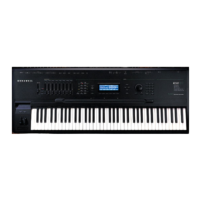1
-
2
Introduction
Rear Panel Features
MIDI
Select
Switch
—Slide switch to select the operation of the MIDI Thru/Out port. This
switch is recessed into the rear panel so that it cannot be accidentally changed.
MIDI
Ports
—In, Thru/Out, and Out ports to connect the PC3x to other MIDI devices to receive,
pass, and send MIDI data.
Display
—Rotary potentiometers to adjust the brightness and contrast of the LCD for the best
visibility.
Figure 1-2 PC3x rear panel, right end
Sync In
—This RCA jack allows the PC3x to receive digital clock signals when it is slaved to
another device.
Digital
Out
—RCA jack to connect to another device with an AES or S/PDIF input via a 75
!
coaxial cable.
Switch
Pedals
—Three 1/4” jacks to connect switch pedals that can be assigned to control
operations such as sustain, sostenuto, etc. (use 1/4” tip/sleeve).
Continuous
Control
Pedals
—Two 1/4” jacks to connect pedals that can be assigned to control
operations such as volume, expression, etc. (use 10K
!
linear taper potentiometer, 1/4”
tip/ring/sleeve, wiper to tip).
Breath
Input
—A 3.5mm jack to connect a standard breath controller to send standard MIDI
Breath messages.
Ribbon
Input
—Modular jack to connect the Kurzweil Ribbon Controller option.
Balanced Analog Outputs
—Four 1/4” balanced audio output jacks. Use the Main outputs, left
(mono) and right, to connect to an amplifier, mixer or sound system. Use the Aux outputs for
monitoring or other operations. They duplicate the Main outputs, but are always in stereo.
Headphones
—Standard 1/4” jack to connect headphones.
Power Entry Module
—includes the power switch, AC receptacle, and the fuse holder/voltage
select compartment. (See Chapter 4, page 4-18 for instructions to change the voltage setting.)
MIDI
Select
Switch
Switch
Pedals
MIDI
Ports
Breath
Input
Sync In
Ribbon
Input
Balanced
Analog Outputs
Continuous
Control Pedals
Headphones
Digital Out
Display
Bright,
Contrast
Power Entry
Module

